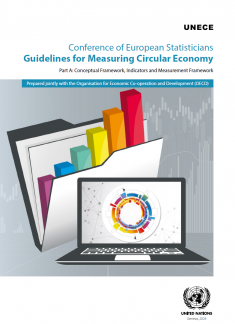In the past two decades, many countries and the European Union have been orienting their waste and materials management policies towards preventive and integrated approaches, with emphasis on the life-cycle and supply chains of materials and products. Policy initiatives aimed at establishing a circular economy (CE) have increased as an essential contribution to a sustainable, low carbon, resource efficient and competitive economy. These developments brought about strong demands for reliable information on a circular economy and raised questions as to the adequacy of the statistics and indicators currently available for effectively supporting national policies and international work. To address these questions, UNECE and OECD joined forces to provide common guidelines for measuring progress.
The type and scope of the information needed to support circular economy (CE) policies depend on how a CE is defined and on the purpose for which the information is needed (for example, policy development, policy monitoring and evaluation, awareness raising, communication, participation). They also depend on whether the information is to be used in international work or to support national policies and initiatives.
There is no single or internationally agreed upon definition of a circular economy. But the definitions used by countries, international institutions and NGOs have many common elements. In all definitions the notion of material circularity is key. Definitions also tend to include reduced demand for certain natural resources and the materials and products derived from them.
This publication clarifies the conceptual understanding of a circular economy from both the policy and the monitoring perspectives. The starting point is a short “headline definition” which highlights the interrelated features of all circular economy definitions: maintaining the value of materials in the economy for as long as possible whilst ensuring a positive outcome to society, and preserving natural capital (natural resources, environmental quality) and human health. The conceptual framework has four main components (material life cycle and value chain, interactions with the environment, socio-economic opportunities, and responses and actions). It is complemented with an initial set of indicators for monitoring progress towards a circular economy and a monitoring framework which discusses important measurement considerations, in particular the use of the System of Environmental Economic Accounting (SEEA) for measuring circular economy. The document also includes examples of measurement frameworks used by countries and other regional and national case examples on measuring the circular economy.
The Conference of European Statisticians (CES) endorsed this “CES Guidelines for Measuring Circular Economy, Part A: Conceptual Framework, Indicators and Measurement Framework” at its seventy-first plenary session which was held from 22–23 June 2023 in Geneva, Switzerland.
It will be complemented with Part B which will provide practical guidance for producing and using statistics to produce the core indicators, the required institutional collaboration and national case examples. Part B is planned to help National Statistical Offices to better understand which elements of the conceptual framework and which of the proposed indicators fall in their responsibility.
